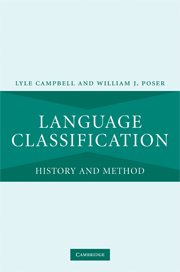Book contents
- Frontmatter
- Contents
- List of figures, tables, and charts
- Acknowledgments
- Preface
- 1 Introduction: how are languages shown to be related to one another?
- 2 The beginning of comparative linguistics
- 3 “Asiatic Jones, Oriental Jones”: Sir William Jones’ role in the raise of comparative linguistics
- 4 Consolidation of comparative linguistics
- 5 How some languages were shown to belong to Indo-European
- 6 Comparative linguistics of other language families and regions
- 7 How to show languages are related: the methods
- 8 The philosophical–psychological– typological–evolutionary approach to language relationships
- 9 Assessment of proposed distant genetic relationships
- 10 Beyond the comparative method?
- 11 Why and how do languages diversify and spread?
- 12 What can we learn about the earliest human language by comparing languages known today?
- 13 Conclusions: anticipating the future
- Appendix: Hypothesized distant genetic relationships
- References
- Index
10 - Beyond the comparative method?
Published online by Cambridge University Press: 22 September 2009
- Frontmatter
- Contents
- List of figures, tables, and charts
- Acknowledgments
- Preface
- 1 Introduction: how are languages shown to be related to one another?
- 2 The beginning of comparative linguistics
- 3 “Asiatic Jones, Oriental Jones”: Sir William Jones’ role in the raise of comparative linguistics
- 4 Consolidation of comparative linguistics
- 5 How some languages were shown to belong to Indo-European
- 6 Comparative linguistics of other language families and regions
- 7 How to show languages are related: the methods
- 8 The philosophical–psychological– typological–evolutionary approach to language relationships
- 9 Assessment of proposed distant genetic relationships
- 10 Beyond the comparative method?
- 11 Why and how do languages diversify and spread?
- 12 What can we learn about the earliest human language by comparing languages known today?
- 13 Conclusions: anticipating the future
- Appendix: Hypothesized distant genetic relationships
- References
- Index
Summary
De Laet [1643] on Hugo Grotius: If you are willing to change letters, to transpose syllables, to add and subtract, you will nowhere find anything that cannot be forced into this or that similarity; but to consider this as evidence for the origin of peoples – this is truly not proved as far as I am concerned.
(Cited in Metcalf 1974:241)Beyond the comparative method?
As we have seen in previous chapters, the criteria for establishing genetic relationships among languages were generally clear, and widely known and applied, with reliance on basic vocabulary, sound correspondences, and patterned grammatical evidence of particular sorts – where the comparative method played a central role. Nevertheless, a number of scholars have recently expressed dissatisfaction with what they perceive to be limitations of the traditional methods. “Since the tried-and-true Neogrammarian comparative method can only reach back a few thousand years before the evidence fades out, something else must be tried,” so declares Johanna Nichols (1996b:267), and recently she and others, recognizing the limitations of the comparative method, have proposed differing ways to see past them. While this goal is an appropriate one, none of the alternative approaches proposed to date has achieved success. In this chapter we assess several of these to show why they do not really reach beyond the limitations of the comparative method.
- Type
- Chapter
- Information
- Language ClassificationHistory and Method, pp. 297 - 329Publisher: Cambridge University PressPrint publication year: 2008



